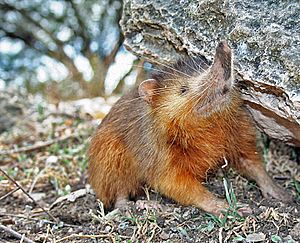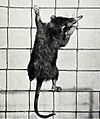Solenodon facts for kids
Quick facts for kids Solenodon |
|
|---|---|
 |
|
| Hispaniolan solenodon | |
| Scientific classification |
|
| Kingdom: | Animalia |
| Phylum: | Chordata |
| Class: | Mammalia |
| Order: | Eulipotyphla |
| Family: | Solenodontidae Gill, 1872 |
| Genus: | Solenodon Brandt, 1833 |
| Type species | |
| Solenodon paradoxus Brandt, 1833
|
|
| Species | |
|
† Solenodon arredondoi |
|
Solenodons are very special mammals that look a bit like large shrews. Their name, "Solenodon," means "slotted-tooth," which refers to a groove in their teeth. This groove helps them deliver venom! Yes, they are one of the few mammals that are venomous, just like some snakes.
These amazing creatures are mostly active at night, which means they are nocturnal. They spend their days hidden away in burrows or other safe spots. Solenodons are also insectivores, meaning they love to eat insects and other small creatures they find.
Meet the Solenodon
There is only one group, or genus, of solenodons, called Solenodon. These animals are quite unique because they have kept some very old, primitive features. This means they look a lot like mammals that lived a very long time ago, even near the end of the age of the dinosaurs! It's like they are living fossils.
Where Do Solenodons Live?
Today, there are two types of solenodons still alive. One is the Cuban Solenodon (Solenodon cubanus), which lives on the island of Cuba. The other is the Hispaniolan solenodon (Solenodon paradoxus), sometimes called the Haitian solenodon. This solenodon lives on the island of Hispaniola, which is shared by the countries of Haiti and the Dominican Republic.
The Hispaniolan solenodon can live in many different places on its island. You might find them in dry forests in lowlands or in pine forests high up in the mountains. They are very adaptable!
Solenodons of the Past
Sadly, two other types of solenodons have become extinct in more recent times. These species disappeared during a period called the Quaternary period. Scientists are always learning more about these ancient animals and how they lived.
Images for kids



